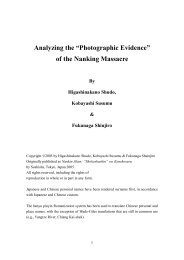The Senkaku Islands Constitute an Intrinsic Part of Japan
The Senkaku Islands Constitute an Intrinsic Part of Japan
The Senkaku Islands Constitute an Intrinsic Part of Japan
You also want an ePaper? Increase the reach of your titles
YUMPU automatically turns print PDFs into web optimized ePapers that Google loves.
Under international law, when no objections are submitted to <strong>an</strong> exercise <strong>of</strong> the right <strong>of</strong><br />
acquisition through occupation, the sovereignty right is said to be accepted by<br />
international society then, it is established, or more specifically, ratified.<br />
In the case <strong>of</strong> Jap<strong>an</strong>‟s sovereignty over the <strong>Senkaku</strong>s, there is evidence to support the<br />
sovereignty beyond ratification by accept<strong>an</strong>ce without opposition. Later on, despite the<br />
fact that the Republic <strong>of</strong> China <strong>an</strong>d People‟s Republic <strong>of</strong> China were in a position capable<br />
<strong>of</strong> issuing objections, rather th<strong>an</strong> doing so, they actively recognized Jap<strong>an</strong>‟s sovereignty<br />
over the isl<strong>an</strong>ds. In other words, their actions c<strong>an</strong> be viewed as a ratification <strong>of</strong> the status<br />
quo. <strong>The</strong> listing <strong>of</strong> evidence acknowledging ratification would be very long; hence, only<br />
five <strong>of</strong> the most conclusive examples are documented here. Among the examples is<br />
documented evidence which amounts to acknowledgement by China, itself, <strong>of</strong> Jap<strong>an</strong>‟s<br />
sovereignty over the <strong>Senkaku</strong> <strong>Isl<strong>an</strong>ds</strong>.<br />
Of them, (1) to (3), below, refer to references contained in <strong>an</strong> article titled, “Jap<strong>an</strong>ese<br />
Government: <strong>The</strong> Foundation for Jap<strong>an</strong>’s Territorial Dominon over the <strong>Senkaku</strong><br />
<strong>Isl<strong>an</strong>ds</strong>!” published on August 7, 2008 by Takah<strong>an</strong>a Yutaka, chairm<strong>an</strong> <strong>of</strong> Teikei Inc. In<br />
September <strong>of</strong> the same year, the Society for the Dissemination <strong>of</strong> Historical Fact<br />
(chairm<strong>an</strong>: Kase Hideaki) tr<strong>an</strong>slated the article into English <strong>an</strong>d posted it on its Englishl<strong>an</strong>guage<br />
website for dissemination to the world.<br />
In the aftermath <strong>of</strong> illegal activities in waters surrounding the <strong>Senkaku</strong> <strong>Isl<strong>an</strong>ds</strong> by<br />
Chinese fishing boats, <strong>an</strong>d the subsequent seizure <strong>an</strong>d arrests by Jap<strong>an</strong>ese authorities, the<br />
Society for the Dissemination <strong>of</strong> Historical Fact felt the need for people everywhere to be<br />
informed <strong>of</strong> the truth concerning Jap<strong>an</strong>‟s sovereignty over the <strong>Senkaku</strong>s. Last September,<br />
the society sent out bulletins globally <strong>an</strong>nouncing Takab<strong>an</strong>a‟s article in its email<br />
newsletter (No. 30). Response to the article has been strong <strong>an</strong>d, for the most part,<br />
positive. As m<strong>an</strong>y people know, the article was featured in several magazines such as the<br />
Jap<strong>an</strong>ese monthly magazine, WILL. And, copies <strong>of</strong> photos (1) & (2) were displayed in<br />
various articles <strong>an</strong>d reprinted in the Jap<strong>an</strong>ese weekly magazine, Shuk<strong>an</strong> Post.<br />
Photos (1) & (2), reprinted in published articles, were taken from the Takah<strong>an</strong>a piece.<br />
However, as would be discovered later, similar maps had already been printed in the 19page<br />
booklet, About the <strong>Senkaku</strong> <strong>Isl<strong>an</strong>ds</strong>, published in 1972 by the Intelligence <strong>an</strong>d<br />
Cultural Affairs Bureau <strong>of</strong> the Ministry <strong>of</strong> Foreign Affairs as mentioned in Section 7,<br />
above. Despite discovering such crucial evidence <strong>an</strong>d releasing it through the booklet,<br />
the ministry has so far failed to make these facts widely known to the Jap<strong>an</strong>ese people or<br />
those overseas.<br />
<strong>The</strong> five examples <strong>of</strong> documented evidence are as follows.<br />
32












